Maybe the Ford Edge will be familiar to you, but then again maybe it won’t. Introduced to the US in 2006 and available for Americans to buy for the best part of a decade, the Edge is now the latest Yank tank to come to Europe as part of the manufacturer’s ‘One Ford’ plan.
Essentially, it’s Ford’s first stab at the premium crossover/SUV market for a number of years and aims to rival the likes of big names like the Audi Q5 and the BMW X3. Slotting above the Kuga and the EcoSport, the Edge will be Ford’s biggest SUV here in the UK, based on the same platform as the Mondeo, S-MAX and Galaxy just as the EcoSport’s based on the Fiesta.
It’s also a car on which Ford is pinning a lot of its hopes. In America last year, Ford sold more Edges than any other model and the marque is keen to repeat that success on this side of the pond with an estimated 60,000 SUV sales in the UK this year, in which the Edge is hoped to play a large part.
Getting down to the nitty gritty, for us Brits the Edge will be available in three trim levels. The entry point starts with the Zetec, which is priced from £29,995, while the mid-level Titanium model starts from £32,245.
Topping the range is the Sport, which will set you back £34,500 in its most basic format, but which comes with a suitably murderous blacked-out grille, along with 20-inch dark grey alloys and a slightly retweaked suspension setup.
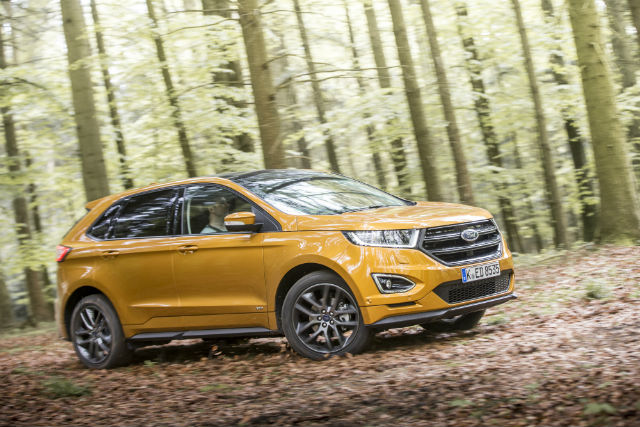
Two diesel engine options
Although the Edge’s chief engineer Matthias Tonn hasn’t ruled out the possibility of more engines joining the range, from launch the Euro-spec car will be available with just two powertrain options, comprising of two versions of the same 2.0-litre TDCi turbodiesel engine.
The entry-level model gets 178bhp and a six-speed manual, while the more powerful option is twin-turbocharged for a maximum output of 208bhp and is available exclusively in the top two trims and only with Ford’s six-speed PowerShift automatic gearbox.
In terms of appearance, the Edge is very obviously styled for the ‘bigger is better’ attitude of its home market, but then that’s no bad thing as the Mustang’s popularity amongst European buyers has recently proven. The Edge’s tall, mean and muscular looks are quite cool, particularly on the Sport model, and cut a more assertive look than the usual European suspects.
It is a big thing, though; although in the US the Edge is one of Ford’s smaller cars, compared to most vehicles on this side of the Atlantic it looks like somebody asked Ford’s engineers for the supersize option. Close to five metres long, nearly two tall and over two wide, it manages to make cars like the X3 look positively dwarfish in comparison.
On the inside, that size translates to a remarkably spacious cabin with an almost identical layout to the popular S-MAX, with which it shares its underpinnings. Up front there’s loads of room for both driver and passenger, while the tall ride height gives a commanding driving position and excellent visibility.
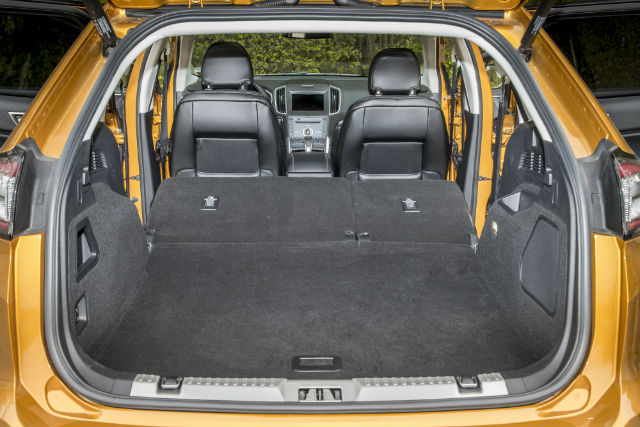
It’s much the same story in the rear, and the Edge beats even the Audi Q5 in terms of interior space, though anybody who wants a seven seater option will be out of luck. Boot space, however, is likewise plentiful with 602 litres with the seats up and luggage cover on, and 1,847 litres with the rear seats folded down.
Standard equipment is generous, with even the base Zetec getting 19-inch alloys, an eight-inch SYNC 2 infotainment system with DAB radio and a rear-view camera, plus a range of driver assistance features like lane departure warning and automatic headlights.
Stepping up to the Titanium and Sport trims will add things like sat-nav, heated and cooled front seats and parking sensors for the front and rear: handy additions for a car of this size. Optional packages add nicer upholstery options and a panoramic roof, while there’s also the option of a 12-speaker Sony sound system.
If there’s one complaint we have it’s that some of the options which buyers will deem most desirable can get pricey quickly. LED lights will cost you more than a grand, while you’ll have to cough up at least £2,000 for the Lux Pack if you want leather seats. As a result, while the Edge might look competitively priced at a glance, once you get the spec to where you want it things can swiftly get expensive, but more on this later.
On, then, to the ride. The first thing to clear up about the Edge is not going to please performance fans in the slightest. This is a cruiser pure and simple, so if you’re looking for F-PACE levels of dynamism, look away now.
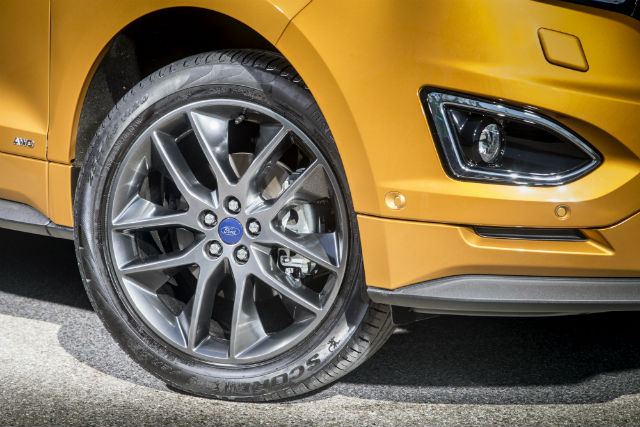
On the road
For a start, the Edge’s sizeable dimensions and weight can be immediately felt under even mild cornering, and a slightly blubbery suspension setup only helps to accentuate the feeling of heaviness as the body leans and rolls under duress.
The steering also has a slightly vague and elastic quality to it, and although it is indeed pleasingly direct and weights up nicely in sport mode, there’s very little by way of feedback. Even the Sport model, with slightly less softly sprung suspension is really more of an aesthetic choice and primarily just for looks.
Not that it bothers us in the slightest, really. Anybody who wants a sporty drive isn’t going to want a car like this anyway, and what the Edge lacks in engagement it more than makes up for by being one of the smoothest and most refined cars in Ford’s range.
Take it off the twisties and show it a smooth and straight stretch of tarmac and it’s at its absolute best. Capable, comfortable and whisper quiet, the Edge also comes with the trick Active Noise Control feature, which uses the same principle as noise-cancelling headphones to mitigate unwanted sounds like wind and tyre roar.
Coupled with the cushy seats and smart interior, the Edge is a car which will get you and the family to your destination in good stead, even if it won’t get you there particularly quickly given the rather laconic performance from the engines. Even the most powerful model does 0-62mph in 9.4 seconds with a top speed of 131mph and the automatic gearbox, while it suits the car well, does tend to be a bit lazy with its shifts.
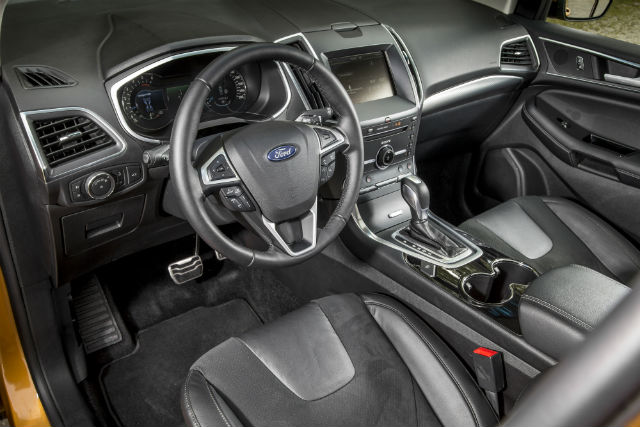
It is surprisingly quite capable off-road, however, given that all models come with intelligent four-wheel drive as standard. No, it’s not a major selling point because nobody who buys a car like this is really likely to use it for mud-plugging, but it’s nice to have all the same.
Do be aware of the Edge’s vast size, which does prove to be something of a drawback to the point that you’ll almost need to specify parking sensors just to cope. It’s a big car and it feels like a big car, which is fine for the jumbo-sized roadways of America but which will struggle on small British B-roads or in tight urban spaces.
All the same, our main complaint with the Edge isn’t the car itself, it’s more a question of economics. There’s no denying that it does its job well, but is it as competitive as Ford hopes when faced with more premium rivals?
Yes, the Zetec undercuts the X3, Q5 and all the rest of its more upmarket opponents by quite a bit, but to get the same amount of kit and quality the Edge becomes almost suicidally close to its rivals, which offer a better drive, potentially better residuals and the benefit of a more image-friendly badge.
Ford has made some great products lately, particularly the Focus RS and the Mustang which have both grabbed headlines left, right and centre and for good reason too. Both offer serious amounts of bang for buck, but they’re also cars which people recognise, cars which people desire and cars with their own dedicated fanbases.
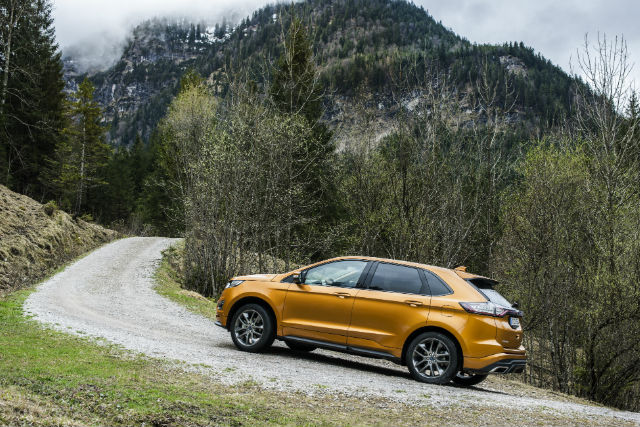
Can it keep up with premium rivals?
The Edge, by contrast, is new to Europe and at present will be unfamiliar to all bar a handful of hardcore Ford fans. It’s a brave strategy, but of course that’s not to say that the Edge is a bad car. If the list price was a little lower and some of the most desirable options part of the standard equipment, the Edge would be a total bargain compared to its rivals.
And yet for the price of a decently-equipped Ford Edge, you could get an SE Line Audi Q5, which has leather seats and xenon headlights as standard, along with a 187bhp 2.0-litre diesel engine. Harsh perhaps, but from the perspective of a buyer with £40k to splash on a new car, would you rather be sat in a Ford dealership or a BMW/Audi one?
Still, Ford itself says that at present the Edge is still very much at its starting point in the European market. Given time and feedback, pricing and options could be adjusted in the future, while the fact that Ford’s engineers aren’t ruling out two-wheel drive and petrol engine options could further expand its consumer base.
In the meantime, although the Edge won’t necessarily put a smile on the face of its driver it’s nonetheless an absolutely fine car with some really strong points, even if we can’t help but feel it’s a bit of a bold move on behalf of Ford.
But then bold seems to be the Ford Edge’s raison d'être. After all, how many other big American SUVs have the gonads to not only attempt to market their Uncle Sam-spec brassiness to the more discerning European market, let alone to directly challenge more premium and image-friendly competitors?



